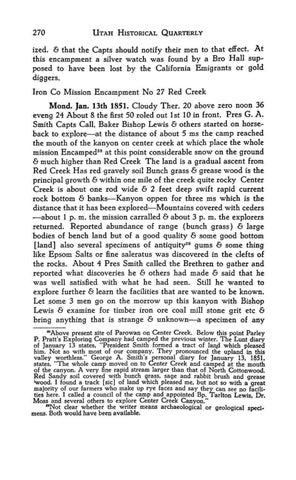270
U T A H HISTORICAL QUARTERLY
ized. & that the Capts should notify their men to that effect. At this encampment a silver watch was found by a Bro Hall supposed to have been lost by the California Emigrants or gold diggers. Iron Co Mission Encampment No 27 Red Creek Mond. Jan. 13th 1851. Cloudy Ther. 20 above zero noon 36 eveng 24 About 8 the first 50 roled out 1st 10 in front. Pres G. A. Smith Capts Call, Baker Bishop Lewis Q others started on horseback to explore—at the distance of about 5 ms the camp reached the mouth of the kanyon on center creek at which place the whole mission Encamped 38 at this point considerable snow on the ground & much higher than Red Creek The land is a gradual ascent from Red Creek Has red gravely soil Bunch grass & grease wood is the principal growth & within one mile of the creek quite rocky Center Creek is about one rod wide & 2 feet deep swift rapid current rock bottom & banks—Kanyon oppen for three ms which is the distance that it has been explored—Mountains covered with ceders —about 1 p. m. the mission carralled & about 3 p. m. the explorers returned. Reported abundance of range (bunch grass) & large bodies of bench land but of a good quality & some good bottom [land] also several specimens of antiquity 39 gums & some thing like Epsom Salts or fine saleratus was discovered in the clefts of the rocks. About 4 Pres Smith called the Brethren to gather and reported what discoveries he & others had made & said that he was well satisfied with what he had seen. Still he wanted to explore further & learn the facilities that are wanted to be known. Let some 3 men go on the morrow up this kanyon with Bishop Lewis & examine for timber iron ore coal mill stone grit etc & bring anything that is strange & unknown—a specimen of any 88 Above present site of Parowan on Center Creek. Below this point Parley P. Pratt's Exploring Company had camped the previous winter. The Lunt diary of January 13 states, "President Smith formed a tract of land which pleased him. Not so with most of our company. They pronounced the upland in this valley worthless." George A. Smith's personal diary for January 13, 1851, states, "The whole camp moved on to Center Creek and camped at the mouth of the canyon. A very fine rapid stream larger than that of North Cottonwood. Red Sandy soil covered with bunch grass, sage and rabbit brush and grease wood. I found a track [sic] of land which pleased me, but not so witii a great majority of our farmers who make up rye faces and say they can see no facilities here. I called a council of the camp and appointed Bp. Tarlton Lewis, Dr. Moss and several otiiers to explore Center Creek Canyon." "Not clear whether the writer means archaeological or geological specimens. Both would have been available.















